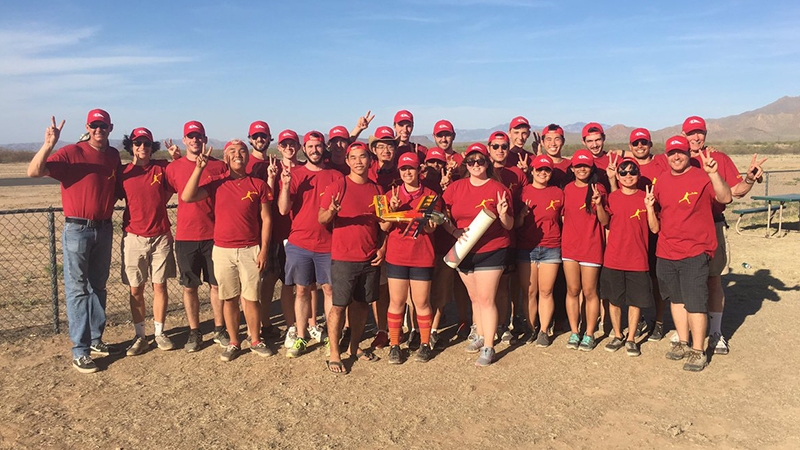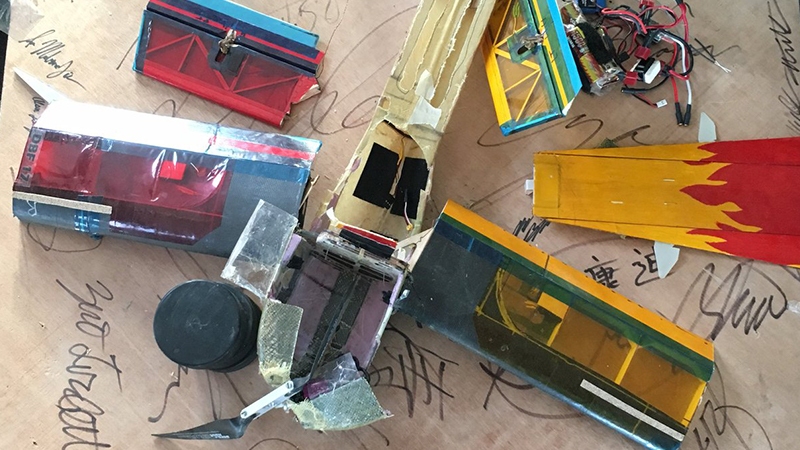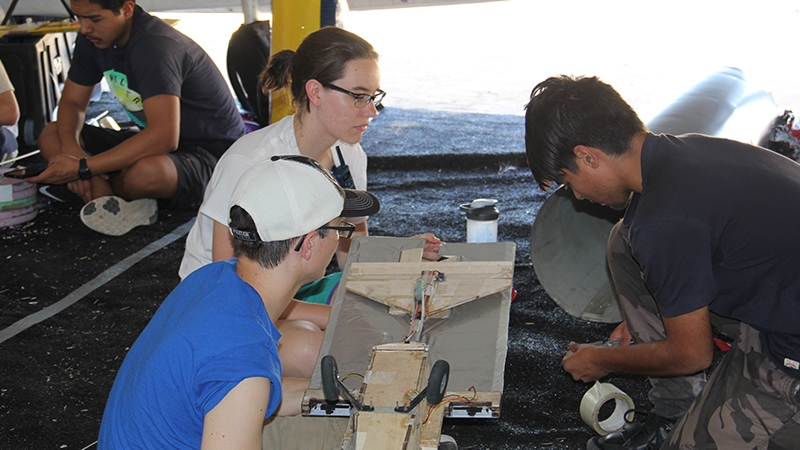Stay Up to Date
Submit your email address to receive the latest industry and Aerospace America news.
University of Southern California students bounced back from a crash to eke out a win Sunday in the 2017 AIAA Design Build Fly contest, while a one-man team from India sparked a kind of international relief effort from dozens of fellow competitors.
DBF, now in its 21st year, pits teams of undergraduate engineering students against each other for a weekend-long competition in which they must conceive and fly a remote controlled aircraft to meet a set of requirements unveiled in September. This year’s competitors had to make a plane that could be stored inside a tube without being disassembled. The plane then had to complete a series of flights at the Tucson International Modelplex Park Association Airfield in Arizona, including one with a payload of hockey pucks. The tube requirement simulated the challenge of designing and building a tube-launched drone, although the competitors launched their aircraft by hand for safety reasons.
USC edged Georgia Tech by 9.34 points to 9.27, unofficially, among the 73 teams and 754 students, but not before its conventional monoplane with a swept tail plummeted to the ground during the competition’s second mission, which focused on speed.
“We had one fairly catastrophic crash,” said USC team member Aaron VanLandingham, a senior from Houston who was participating in his fourth DBF. “We went back to our hotel and rebuilt it, and came back with a rebuilt plane and flew the mission.”
The three flight missions consisted of a demonstration flight of three laps around the course, a three-lap speed flight with a payload of three regulation hockey pucks, and a five-minute range flight which scored teams based on the number of laps flown and hockey pucks carried.
Dreamed up by professional engineers in 1997 to give college students practical experience, AIAA Design Build Fly has become one of the largest flyoffs for college teams. AIAA Associate Fellow
Russ Althof, an engineer with Raytheon Missile Systems in Tucson and this year’s DBF contest administrator, said the addition of a half day to the schedule made it “one of the best we’ve ever done. It really worked out to where everybody who wanted to have an opportunity to fly had all the opportunities they wanted.”
VanLandingham said the USC team started its analysis of the scoring system as soon as the rules were released in September and determined that a “high performance” light plane capable of carrying three hockey pucks during the range flight stood the best chance of winning. “There were some complex elements of the equation that incentivized a small and light plane,” he said.
Teams were awarded points based on their written design report and scores in the missions, which were challenging due to the winds on two afternoons. That total was then divided by the rated aircraft cost, a figure based on the aircraft’s empty weight and the launch tube’s weight, length and circumference.
In addition to the flight mission, the DBF included a ground mission that required the tube, with the aircraft inside, to be capable of being dropped three times from a height of 30.48 cm without sustaining significant damage. The aircraft then had to be removed from the tube in one piece and readied for flight. Parts could be moved using hinges and other mechanisms, but could not be temporarily separated from the aircraft. No tools could be used during the process.
“You had to design it such that everything was self-locking,” VanLandingham said.
The USC aircraft is 457 millimeters long, with an empty weight of 0.658 kilograms and a 0.274 square meter wing area. The team made the fuselage of Kevlar and carbon fiber, and the wing and tail of balsa wood. Their craft flew 29 meters per second in test flights and completed 40 laps during the competition, VanLandingham said. USC’s plane fit inside a 114 mm diameter tube.
“There were some lighter planes, and some faster planes,” VanLandingham said. “Our success came from being competitive in all aspects of the design.”
VanLandingham says USC, which has won AIAA’s contest two previous times, participates in other competitions too. “We like this one because it presents a new challenge every year,” he said. This year’s first prize is $2,500.
USC brought 20 team members to DBF. By contrast, Ribhu Bhatia, a student at SRM University in India, came to the competition by himself. He completed the ground mission and demo flight mission, then crashed hard, like USC, during the speed flight mission. When that happened, students from a dozen teams donated parts and time to help him rebuild his aircraft (Photo at top of story). The assistance meant he couldn’t officially compete anymore, but organizers let him make the last flight of the event, which he completed to cheers from the crowd, with logos of all 12 assisting teams on the aircraft. “I wouldn’t have been able to get score if it wasn’t for these guys,” Bhatia said.
Bhatia said SRM was taking part in the competition for the first time this year. He said one of his team members couldn’t travel to the U.S. because his request for a visa was rejected, the other because his parents are ill.
“When I got here, I got here alone,” he said. “Then I met the Embry team,” he said referring to the team from Embry-Riddle Aeronautical University of Daytona Beach, Florida.
The students hit it off, with the Embry team dubbing him “Boo,” short for Ribhu. Embry-Riddle senior Zachary Lietzau said the team shared photos with Bhatia’s parents by email and facilitated phone calls from Bhatia’s mother.
“They are great as a family to take care of me,” Bhatia said. And they may be seeing more of him. Bhatia, who will receive his bachelor’s degree next year, now plans to apply to Embry-Riddle for graduate school.
Here are the Top 10 teams from this year’s competition:
- University of Southern California
- Georgia Tech
- University of Ljubljana, Slovenia
- Massachusetts Institute of Technology
- Oregon State University
- University of Oklahoma
- Veermata Jijabai Technological Institute, Pakistan
- Embry-Riddle Aeronautical University, Daytona Beach
- California Polytechnic State University
- San Jose State University
About Joe Stumpe
A freelance reporter based in Wichita, Kansas, Joe has written for The New York Times, Agence France-Presse and The Huffington Post.
Related Posts
Stay Up to Date
Submit your email address to receive the latest industry and Aerospace America news.






